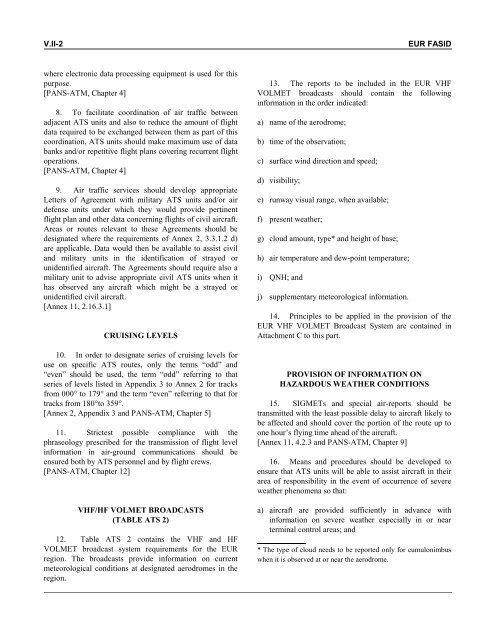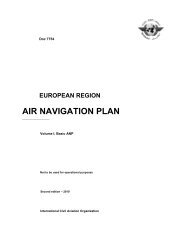7754 Vol 2 Flyleaf - ICAO Public Maps
7754 Vol 2 Flyleaf - ICAO Public Maps
7754 Vol 2 Flyleaf - ICAO Public Maps
Create successful ePaper yourself
Turn your PDF publications into a flip-book with our unique Google optimized e-Paper software.
V.II-2<br />
EUR FASID<br />
where electronic data processing equipment is used for this<br />
purpose.<br />
[PANS-ATM, Chapter 4]<br />
8. To facilitate coordination of air traffic between<br />
adjacent ATS units and also to reduce the amount of flight<br />
data required to be exchanged between them as part of this<br />
coordination, ATS units should make maximum use of data<br />
banks and/or repetitive flight plans covering recurrent flight<br />
operations.<br />
[PANS-ATM, Chapter 4]<br />
9. Air traffic services should develop appropriate<br />
Letters of Agreement with military ATS units and/or air<br />
defense units under which they would provide pertinent<br />
flight plan and other data concerning flights of civil aircraft.<br />
Areas or routes relevant to these Agreements should be<br />
designated where the requirements of Annex 2, 3.3.1.2 d)<br />
are applicable. Data would then be available to assist civil<br />
and military units in the identification of strayed or<br />
unidentified aircraft. The Agreements should require also a<br />
military unit to advise appropriate civil ATS units when it<br />
has observed any aircraft which might be a strayed or<br />
unidentified civil aircraft.<br />
[Annex 11, 2.16.3.1]<br />
CRUISING LEVELS<br />
10. In order to designate series of cruising levels for<br />
use on specific ATS routes, only the terms “odd” and<br />
“even” should be used, the term “odd” referring to that<br />
series of levels listed in Appendix 3 to Annex 2 for tracks<br />
from 000 to 179 and the term “even” referring to that for<br />
tracks from 180to 359.<br />
[Annex 2, Appendix 3 and PANS-ATM, Chapter 5]<br />
11. Strictest possible compliance with the<br />
phraseology prescribed for the transmission of flight level<br />
information in air-ground communications should be<br />
ensured both by ATS personnel and by flight crews.<br />
[PANS-ATM, Chapter 12]<br />
VHF/HF VOLMET BROADCASTS<br />
(TABLE ATS 2)<br />
12. Table ATS 2 contains the VHF and HF<br />
VOLMET broadcast system requirements for the EUR<br />
region. The broadcasts provide information on current<br />
meteorological conditions at designated aerodromes in the<br />
region.<br />
13. The reports to be included in the EUR VHF<br />
VOLMET broadcasts should contain the following<br />
information in the order indicated:<br />
a) name of the aerodrome;<br />
b) time of the observation;<br />
c) surface wind direction and speed;<br />
d) visibility;<br />
e) runway visual range, when available;<br />
f) present weather;<br />
g) cloud amount, type* and height of base;<br />
h) air temperature and dew-point temperature;<br />
i) QNH; and<br />
j) supplementary meteorological information.<br />
14. Principles to be applied in the provision of the<br />
EUR VHF VOLMET Broadcast System are contained in<br />
Attachment C to this part.<br />
PROVISION OF INFORMATION ON<br />
HAZARDOUS WEATHER CONDITIONS<br />
15. SIGMETs and special air-reports should be<br />
transmitted with the least possible delay to aircraft likely to<br />
be affected and should cover the portion of the route up to<br />
one hour’s flying time ahead of the aircraft.<br />
[Annex 11, 4.2.3 and PANS-ATM, Chapter 9]<br />
16. Means and procedures should be developed to<br />
ensure that ATS units will be able to assist aircraft in their<br />
area of responsibility in the event of occurrence of severe<br />
weather phenomena so that:<br />
a) aircraft are provided sufficiently in advance with<br />
information on severe weather especially in or near<br />
terminal control areas; and<br />
* The type of cloud needs to be reported only for cumulonimbus<br />
when it is observed at or near the aerodrome.














